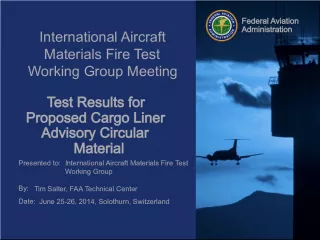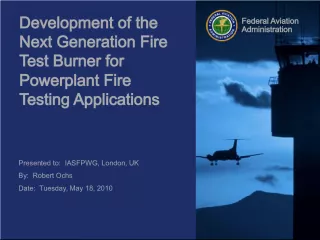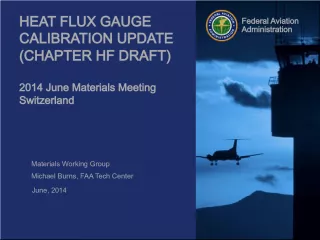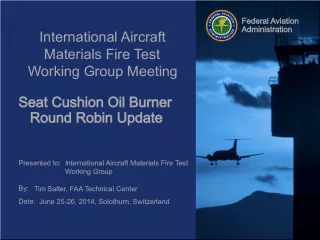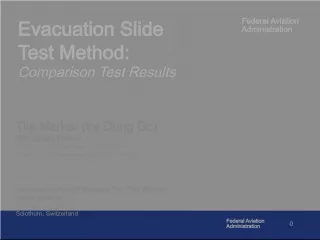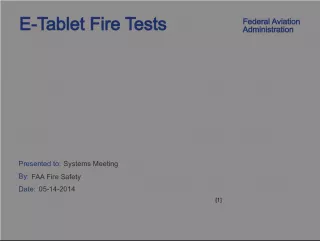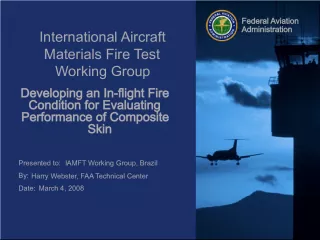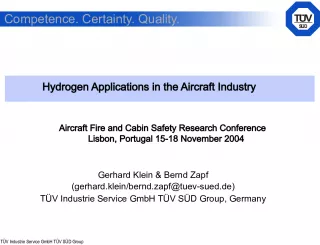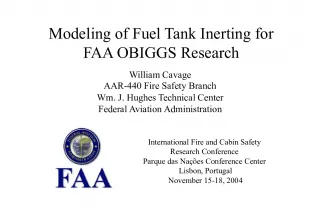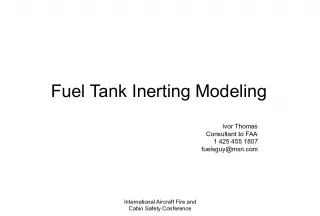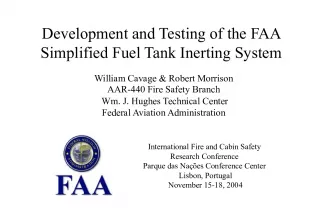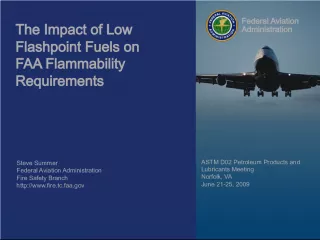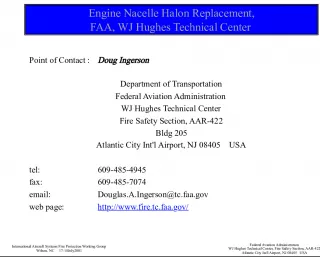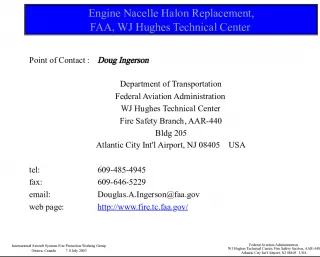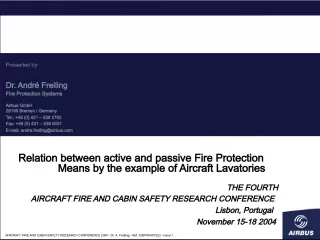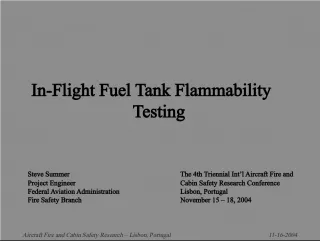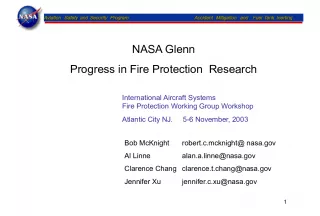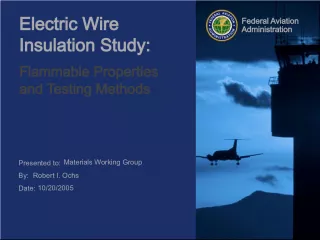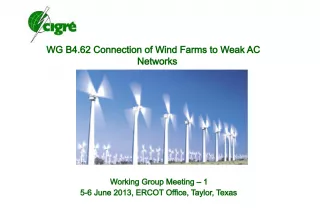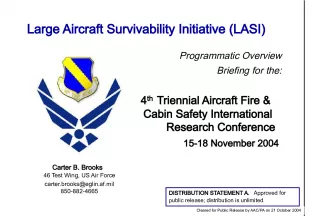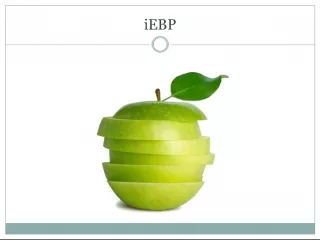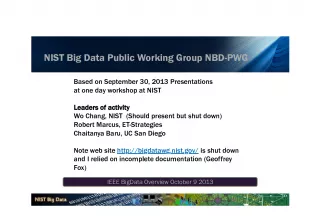Federal Aviation Administration NexGen Burner Update at International Aircraft Materials Fire Test Working Group Meeting
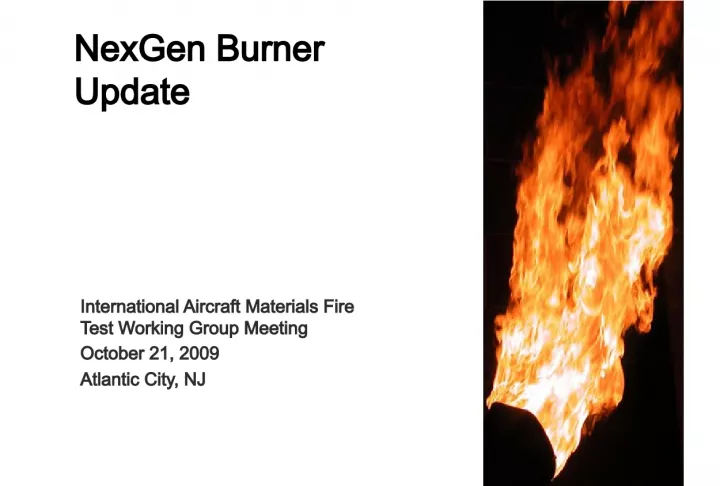

This article discusses the updates shared by the Federal Aviation Administration (FAA) on the NexGen Burner at the International Aircraft Materials Fire Test
- Uploaded on | 1 Views
-
 ailingrimsrud
ailingrimsrud
About Federal Aviation Administration NexGen Burner Update at International Aircraft Materials Fire Test Working Group Meeting
PowerPoint presentation about 'Federal Aviation Administration NexGen Burner Update at International Aircraft Materials Fire Test Working Group Meeting'. This presentation describes the topic on This article discusses the updates shared by the Federal Aviation Administration (FAA) on the NexGen Burner at the International Aircraft Materials Fire Test. The key topics included in this slideshow are . Download this presentation absolutely free.
Presentation Transcript
Slide1Federal AviationAdministration NexGen Burner Update International Aircraft Materials Fire Test Working Group Meeting October 21, 2009 Atlantic City, NJ
Slide2Burnthrough UpdateIAMFTWG, Atlantic City, NJ 2 Federal Aviation Administration Outline • Background • NexGen Burner Drawings • Recent findings
Slide3Burnthrough UpdateIAMFTWG, Atlantic City, NJ 3 Federal Aviation Administration What is a NexGen Burner? • The next generation (NexGen) burner was designed by the FAA Technical Center to be used as an equivalent burner to the Park DPL 3400 which is no longer in production • The NexGen burner relies on the same operating principles as the Park DPL 3400, which was designed for home heating purposes – Oil burner fuel nozzle, 80 °hollow cone, 6.0 gph – Air flow approx 1350 fpm exiting draft tube – Average flame temperature ~ 1900°F – Average flame heat flux ~ 15 BTU/ft 2 s • The NexGen burner uses compressed air and fuel to supply the burner, whereas the Park DPL 3400 uses an electric motor to spin a blower fan and mechanical fuel pump – Air Flow Metering: • Park uses a butterfly throttle valve • NexGen uses a sonic orifice – Fuel Pressure • Park uses pressure regulator on pump • NexGen uses fuel tank head pressure • Major advantages of a NexGen burner: – Precise metering of inlet parameters – Can be constructed in-house with easily obtainable materials – Can be easily modified for future upgrades (as a result of FAATC research) Park DPL 3400 NexGen Burner
Slide4Burnthrough UpdateIAMFTWG, Atlantic City, NJ 4 Federal Aviation Administration NexGen Drawings • Drawings are available online at http://www.fire.tc.faa.gov/pdf/materials/NexGenPlans.pdf
Slide5Burnthrough UpdateIAMFTWG, Atlantic City, NJ 5 Federal Aviation Administration Remanufactured Stators and Turbulators • MarlinEngineering, Inc was able to digitize the original stator and turbulator • Irregularities were corrected in design software, symmetry was restored to design • A computer numerical controlled (CNC) mill was used to cut new, corrected stators and turbulators • The new prototypes were sent to the FAA Tech Center for evaluation and comparison with a properly configured NexGen burner
Slide6Burnthrough UpdateIAMFTWG, Atlantic City, NJ 6 Federal Aviation Administration Original Turbulator Prototype Turbulator Front View
Slide7Burnthrough UpdateIAMFTWG, Atlantic City, NJ 7 Federal Aviation Administration Original Turbulator Prototype Turbulator Rear View
Slide8Burnthrough UpdateIAMFTWG, Atlantic City, NJ 8 Federal Aviation Administration Original Turbulator Prototype Turbulator
Slide9Burnthrough UpdateIAMFTWG, Atlantic City, NJ 9 Federal Aviation Administration Original Modified Stator Prototype Stator
Slide10Burnthrough UpdateIAMFTWG, Atlantic City, NJ 10 Federal Aviation Administration Comparison Tests • Datum: – FAA NexGen 2 burner – Constructed as per FAA NexGen burner guidelines ( http://www.fire.tc.faa.gov/pdf/materials/NexGenPlans.pdf ) • A new draft tube was made to fit the precise 4” round stator – Original 4” i.d. pipe is not perfectly round – Stator could have been cut, but then we would have 2 imperfect parts – Tube was honed out to precisely fit the new stator – In the future, extruded tube with tight tolerance may be necessary for re- engineered CNC stators
Slide11Burnthrough UpdateIAMFTWG, Atlantic City, NJ 11 Federal Aviation Administration
Slide12Burnthrough UpdateIAMFTWG, Atlantic City, NJ 12 Federal Aviation Administration Comparison Tests • Testing was performed on the picture frame sample holder with polyacrylonitrile (PAN) materials of 2 densities • Samples were kept in conditioning chamber until testing
Slide13Burnthrough UpdateIAMFTWG, Atlantic City, NJ 13 Federal Aviation Administration Average of 4 Tests
Slide14Burnthrough UpdateIAMFTWG, Atlantic City, NJ 14 Federal Aviation Administration Results • The new stator and turbulator had no significant effect on overall flame temperature or burnthrough times of PAN materials • These new parts could be considered equivalent to the Monarch H215 stator and F124 turbulator
Slide15Burnthrough UpdateIAMFTWG, Atlantic City, NJ 15 Federal Aviation Administration NexGen, Burnthrough, and PIV Task Group • Discuss plans, construction of burner with those interested in building a burner • Discuss remanufactured stator and turbulator • NexGen burner for other tests (seat cushion, cargo liner, powerplants)
Slide16Burnthrough UpdateIAMFTWG, Atlantic City, NJ 16 Federal Aviation Administration Questions? Contact: Robert Ochs DOT/FAA Tech Center BLDG 287 Atlantic City Int’l Airport NJ 08405 robert.ochs@faa.gov 1 609 485 4651
